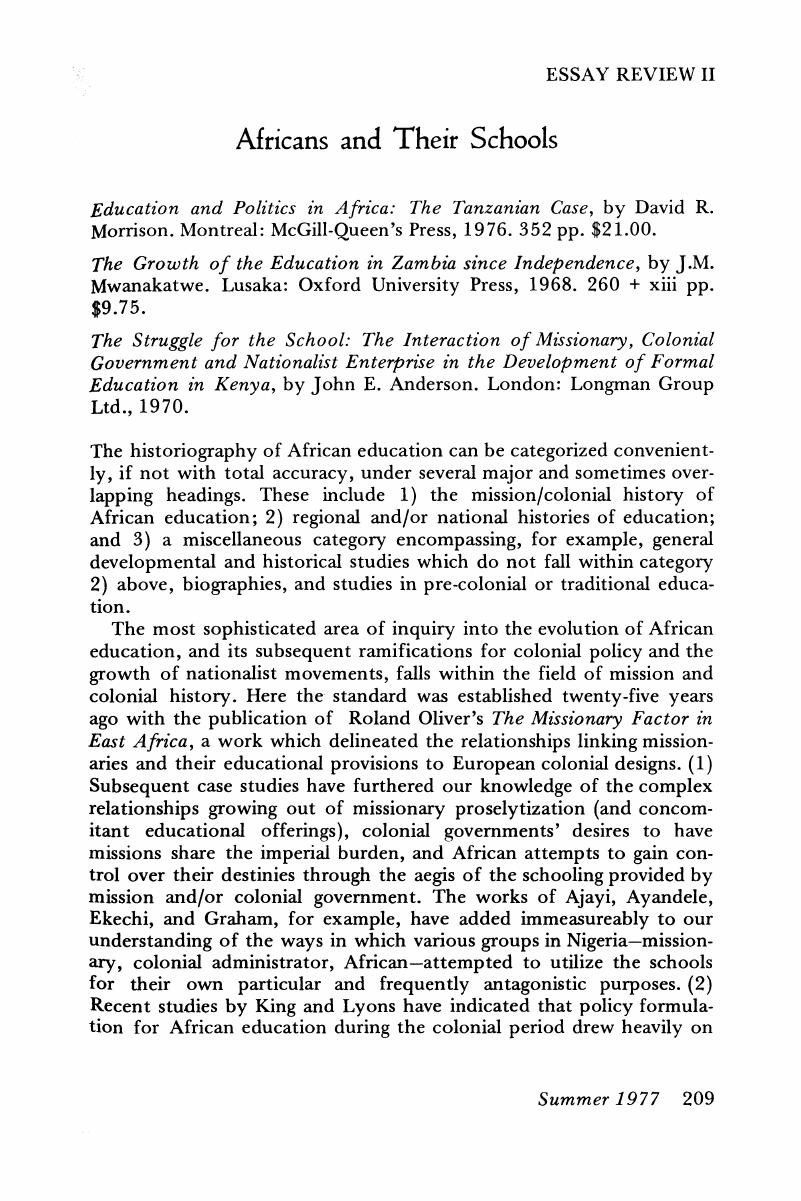No CrossRef data available.
Article contents
Africans and Their Schools - Education and Politics in Africa: The Tanzanian Case, by David R. Morrison. Montreal: McGill-Queen's Press, 1976. 352 pp. $21.00. - The Growth of the Education in Zambia since Independence, by J.M. Mwanakatwe. Lusaka: Oxford University Press, 1968. 260 + xiii pp. $9.75. - The Struggle for the School: The Interaction of Missionary, Colonial Government and Nationalist Enterprise in the Development of Formal Education in Kenya, by John E. Anderson. London: Longman Group Ltd., 1970.
Published online by Cambridge University Press: 24 February 2017
Abstract

- Type
- Essay Review II
- Information
- Copyright
- Copyright © 1977 by New York University
References
Notes
1. Oliver, Roland, The Missionary Factor in East Africa (London, 1952).Google Scholar
2. Ajayi, J.F.A., Christian Missions in Nigeria, 1841–1819: The Making of a New Elite (Evanston, 1965); Ayandele, E.A., The Missionary Impact on Modern Nigeria, 1842–1914 (New York, 1966); Ekechi, F.K., Missionary Enterprise and Rivalry in Igboland, 1857–1914 (London, 1971); Graham, Sonia F., Government and Mission Education in Northern Nigeria, 1900–1919 (Ibadan, 1966).Google Scholar
3. King, Kenneth J., Pan-Africanism and Education: A Study of Race Philanthropy and Education in the Southern States of America and East Africa (Oxford, 1971); Lyons, Charles H., To Wash an Aethiop White: British Ideas about Black African Educability, 1530–1960 (New York, 1975).Google Scholar
4. Ashby, Eric, Universities: British, Indian, African (Cambridge, Mass., 1966); Murphy, E. Jefferson, Creative Philanthropy: The Carnegie Corporation and African Education, 1953–1973 (New York, 1976); Hunter, Guy, Education for a Developing Region: A Study in East Africa (London, 1963).Google Scholar
5. Wraith, R.E., Guggisberg (London, 1967); Perham, Margery, Lugard: The Years of Authority, 1898–1945 (London, 1960); Livingston, Thomas W., Education and Race: A Biography of Edward Wilmot Blyden (San Francisco, 1975).Google Scholar
6. Kenyatta, Jomo, Facing Mount Kenya (London, 1938); Nadel, S.F., A Black Byzantium (London, 1943); Little, Kenneth, The Mende of Sierra Leone (London, 1951); Smith, M.F., Baba of Karo: A Woman of the Muslim Hausa (London, 1954); Peshkin, Alan, Kanuri Schoolchildren: Education and Social Mobilization in Nigeria (New York, 1972); Trimingham, J.S., Islam in West Africa (Oxford, 1959); and Bello, A., My Life (Cambridge, 1962).Google Scholar
7. Abernethy, David B., The Political Dilemma of Popular Education: An African Case (Stanford, 1969); Foster, Philip J., Education and Social Change in Ghana (London, 1965).Google Scholar
8. Quoted in Fagen, Richard R., The Transformation of Political Culture in Cuba (Stanford, 1969), p. 2.Google Scholar
9. Lofchie, Michael F. (ed.), The State of Nations: Constraints on Development in Africa (Berkeley, 1971), comments at length on these differences and what they portend for development in Africa.Google Scholar
10. Several autobiographical accounts indicate the tenacity with which Africans pursued the opportunities to attend school. See, for example, Gatheru, R. Mugo, Child of Two Worlds: A Kikuyu's Story (New York, 1964); and Fox, Lorene K. (ed.), East African Childhood: Three Versions (Nairobi, 1967).Google Scholar
11. My concern that the history of education in Africa needed to be told from the African perspective was what motivated me to begin work on my African Reactions to Missionary Education (New York, 1975).Google Scholar
12. See Shepperson, George and Price, Thomas, Independent African: John Chilembwe and the Origins, Setting and Significance of the Nyasaland Native Rising of 1915 (Edinburgh, 1958); and Ranger, T.O., “African Attempts to Control Education in Central and East Africa,” Past and Present, (December 1965).Google Scholar
13. Denham, Edward B. to Jones, Thomas Jesse, June 4, 1924, Archives of the Conference of Missionary Societies of Great Britain and Ireland, London, Box 232.Google Scholar
14. Other attempts by Africans to establish independent schools during the colonial period are documented by Shepperson, and Price, , op. cit. , Ranger, , op. cit., and Webster, J.B., The African Churches among the Yoruba, 1880–1922 (Oxford, 1964).Google Scholar
15. See Strayer, R.W., “The Church Missionary Society in Eastern and Central Kenya, 1875–1935: A Mission Community in a Colonial Society (unpublished Ph.D. dissertation, University of Wisconsin, 1971).Google Scholar
16. Ranger, , op. cit., discusses the use made of this school by the Lozi elite, as does Caplan, Gerald, The Elites of Barotseland, 1878–1969: A Political History of Zambia's Western Province (Berkeley and Los Angeles, 1970).Google Scholar
17. Cf. Mwanakatwe's lack of analysis with the thrust of Foster's argument regarding education in Ghana in Education and Social Change in Ghana. Foster argues that acceptance of western education is directly related to changes in the social structure of African societies brought about by outside modernizing forces. In particular, he notes that African demands for western education were highly correlated with the vocational opportunities available to them in the evolving exchange economy. If we accept this argument, it follows that inducements—in the form of wages, status, opportunity—will have to be offered to encourage African school children to follow a non-academic curriculum.Google Scholar
18. For an explication of this point, see Hanf, Theodor, et al., “Education—An Obstacle to Development? Reflections on the Political Function of Education in Asia and Africa,” Comparative Education Review, vol. 19, No. 1 (February 1975).Google Scholar




